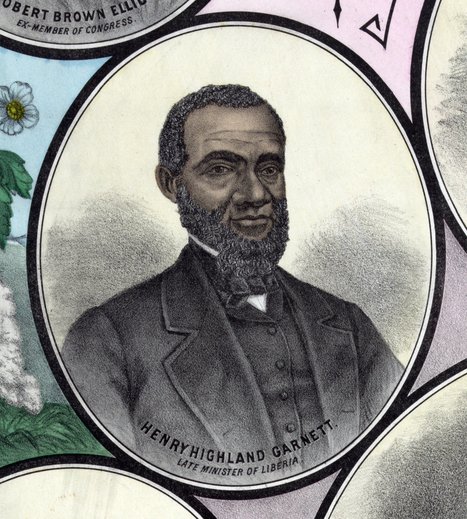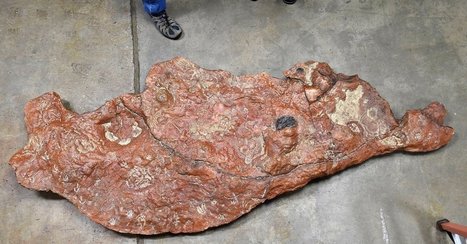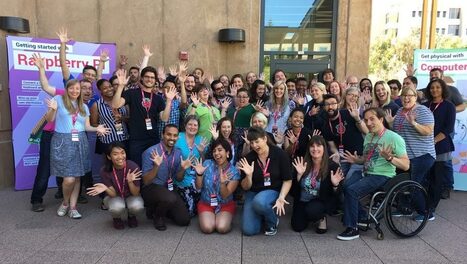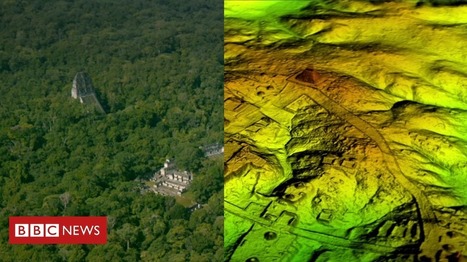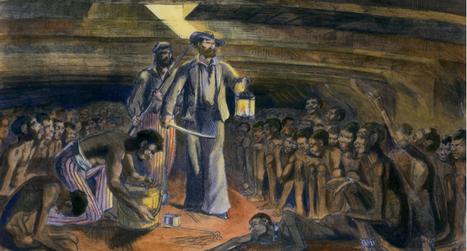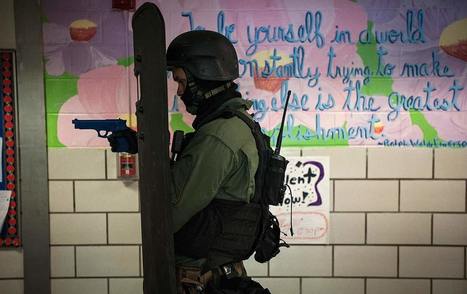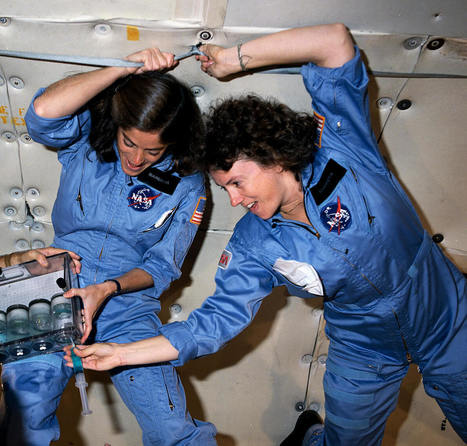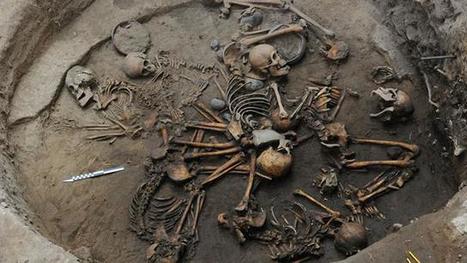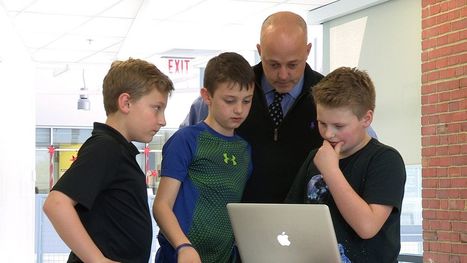 Your new post is loading...
 Your new post is loading...
In a conference call from Career Communications Group’s head office Wednesday, Oct. 25, Career Communications Group CEO and publisher Tyrone Taborn informed automotive executive Alicia Boler Davis that she had been voted 2018 Black Engineer of the Year by the Black Engineer of the Year Awards (BEYA) Selection Committee.
The 16-person BEYA Selection Committee is made up of leading scientists and engineers from the federal government, academia, and industry.
When Boler Davis accepts the torch as the thirty-second Black Engineer of the Year in the nation’s capital February 2018, she will be the sixth woman to receive this award from the Council of Engineering Deans of the nation’s Historically Black Colleges and Universities, which graduate more than 33 percent of all black engineers in the United States.
Click headline to read more--
In a recent Atlantic article, Alana Semuels asks: “Why have high-profile organizing campaigns succeeded for white-collar workers and failed for blue-collar workers?” Semuels presents new BLS data that demonstrates the growth of white-collar unions: Union membership in professional and technical jobs grew by nearly 90,000 last year, and several white-collar occupations saw an uptick in union density, which grew from 4 percent in 2010 to 7 percent in 2017. Contrasting this with recent defeats of blue-collar unionization drives, Semuels argues that there is a growing “class divide” within organized labor. This, she argues,
"is yet another dynamic of an increasingly bifurcated American economy. As jobs for educated workers continue to proliferate in this economy, educated workers feel secure, sure that they’ll be able to find more work if they lose their jobs. In some cases, that security may mean they feel they can advocate for a union, or stand up to employer threats to shut the workplace down if a union forms."
But this is where Semuels’s argument reveals its flaw: White-collar workers aren’t organizing because they feel secure, but because they have more in common with precarious blue-collar workers than ever.
Click headline to read more and access hot links--
Today, the Reverend Dr. Henry Highland Garnet is the most famous African American you never learned about during Black History Month. In the 19th century however, Garnet, who lived from 1815 to 1882, was recognized as one of the foremost anti-slavery organizers in the world. He was the founding president of the American and Foreign Anti-Slavery Society, an organization that waged international campaigns against human trafficking and Cuban patriot José Martí called him America’s “Moses.”
And, though he is often left out of the popular story of abolition, Rev. Garnet’s work of building bridges of solidarity offers a unique perspective on what it means for the U.S. to value human rights in an international context in the 21st century.
Click headline to read more and access hot links--
More than 100 million years ago, dinosaurs roamed Maryland. So did our ancestors — small mammals the size of squirrels or badgers — and the flying reptiles known as pterosaurs.
Amazingly, the footprints of all these creatures of the Cretaceous era were preserved on a single 8.5-foot-long slab of sandstone unearthed on the grounds of NASA’s Goddard Spaceflight Center in Greenbelt, Md., not far north of the nation’s capital.
“It’s unusual to have such a large concentration of different kinds of tracks and small tracks in such a small space,” said Martin Lockley, an emeritus geology professor at the University of Colorado Denver who studied the tracks.
Click headline to read more, access hot links and view pix and graphic--
"Turn on the subtitles, Ms. Olague!" I clicked on the "CC" button underneath the YouTube video, and the closed-captioning appeared at the bottom of the screen. Suddenly, all my students were looking at the screen with wide eyes, eager to watch the video. In my first-grade classroom, a third of my students were learning English as a second language. Though my English learners were the initial reason I starting using closed-captioning on videos, I soon realized that students with special needs also benefited. As a public school teacher, I had to constantly evaluate how my teaching practices and materials could better include and empower the vast diversity in my classroom.
My students loved having subtitles on during short videos because it gave them more opportunities to interact with and learn from the content. All my students were learning how to read, and the captions helped them connect the audio to the visual representation of text. Plus, the students who struggled with attention didn't miss out on any information since they could access the content through the voice-over, the visuals in the video, and the text in the captions. I used closed-captioning with BrainPop Jr. content, ClassDojo videos, GoNoodle, and other phonics or science videos on YouTube.
Click headline to read more and access hot links--
Picademy is the Raspberry Pi Foundation’s free, two-day training program that helps educators jump start their digital making journey. You’ll learn how to bring coding to life and explore new ways to create with technology.
Since 2016, Picademy has reached over 400 educators in North America and supported them to teach computing with confidence, creativity, and excitement.
Click headline to read more and access hot links--
Data from 160,000 ranked chess players and more than five million chess matches suggests that women playing against men perform better than expected based on their official chess ratings, according to a new study by the University of Sheffield.
The findings, published in the journal Psychological Science, suggest that female players are not affected by negative stereotypes about women's chess abilities during competition games. This is in contrast with previous findings on the phenomenon of stereotype threat which have suggested that awareness of negative stereotypes can hamper women's performance.
Click headline to read more and access hot links--
Laser technology was used to survey digitally beneath the forest canopy, revealing houses, palaces, elevated highways, and defensive fortifications.
The landscape, near already-known Maya cities, is thought to have been home to millions more people than other research had previously suggested.
The researchers mapped over 810 square miles (2,100 sq km) in northern Peten.
Archaeologists believe the cutting-edge technology will change the way the world will see the Maya civilisation.
Click headline to read more and view pix--
Translating ideas into presentations is not as easy as it might seem, which I’m sure you know by now. How many hours have you spent searching the web for resources for presentation design, preferably free ones?
Sometimes opening a new presentation is a bit frightening. Organizing your thoughts in this beautifully designed document is a real challenge especially if you’re pressed for time or are juggling multiple tasks.
Here, at Visual Hackers, we want to help your creative juices flow faster so we’re going to share some of our favorite websites that offer free presentation design resources such as templates, icons, images, vectors, fonts and more.
Click headline to read more and access hot links--
Black History Month starts on Thursday, almost a century after Carter G Woodson first conceived of the idea. This animation shows how the geography of black America today has changed since then.
Click headline to read more, view map and watch video clip--
We can hardly understand America without understanding American history. Can we understand American history without understanding slavery? Many a historian would answer with an unqualified no, and not simply because they want to see Americans meditate on the sins of their ancestors: plunging into the controversies around slavery, seeing how Americans made arguments for and against it at the time, can help us approach and interpret the other large-scale legal and moral battles that have since raged in the country, and continue to rage in it today.
The Boston Public Library's Anti-Slavery Collection, one particularly important resource in that intellectual effort, could use our help in making its considerable resources more readily available.
Click headline to read more and access hot links--
When we read books, why do we forget so much of what we read, in only weeks or even days after we read it?
Coming across an article on this topic by Julie Beck in The Atlantic over the weekend, I found insight and even some consolation. I'm not the only one who forgets the plots of novels I've truly loved.
Beck explains that as we read a book, it feels like a fluent experience when we're absorbed in the text. The material that we're taking in, though, is being held only in working memory. It takes concentrated effort to "set" that material in long-term memory. Beck writes:
Click headline to read more and access hot links--
A University of Florida initiative formed in St. Augustine is bringing more innovation to historic preservation.
While the Preservation Institute St. Augustine launched in April 2017, officials are developing initiatives and specific goals, program director Marty Hylton said. The program is a branch of the university’s efforts to preserve state-owned historic buildings in St. Augustine.
“The mission [of PISA] is really to document and preserve and interpret the historic architecture and cultural resources of the city while affording students and faculty from UF the opportunity to apply research and learn,” Hylton said.
One idea in the works is having a preservation materials conservation lab in the city, where the university would study materials used in historic structures and how to better preserve them. Hylton said the goal is to have a lab and a director operating at at Governor’s House Cultural Center and Museum in St. Augustine.
Click headline to read more and view pix--
|
Just eight percent of American high school seniors can identify the cause of the Civil War; less than a third (32 percent) know which amendment abolished slavery in the U.S.; and fewer than half (46 percent) know that the "Middle Passage" refers to the harrowing voyage across the Atlantic undertaken by Africans kidnapped for the slave trade. These are only a few of the more unnerving findings from the Southern Poverty Law Center’s Teaching Tolerance project, which concludes that in classrooms across the country, the subject of slavery is as mistaught as it is misunderstood.
Drawing from online surveys of 1,000 12th-graders and more than 1,700 social studies teachers, along with an exhaustive analysis of the 10 most widely read U.S. history textbooks, the SPLC's latest report attempts to assess how well the country understands its original sin. In a word, the results are "abysmal".
Click headline to read more and access hot links--.
Within the first 23 days of 2018, there were 11 school shootings in the United States. In lieu of any serious discussion about gun control, there has been instead a proliferation of laws and bills that would arm teachers, and train them to be able to kill.
Observes Adam Skaggs, of the Giffords Law Center to Prevent Gun Violence, “it’s the idea that people need guns everywhere—city streets, public parks, even government buildings.” It’s also the response of a nation at war with itself.
Click headline to read more and access hot links--
The Mayan civilization was much bigger than anyone realized — on a par with ancient Greece or China, according to a major archaeological breakthrough.
Researchers have digitally unearthed more than 60,000 man-made ruins — including palaces, cities and elevated highways — that have been hidden for centuries in the jungles of northern Guatemala, National Geographic reports.
The Mayan civilization was previously believed to be populated by 5 million people, but the breakthrough shows it may have been up to three times bigger, according to the archaeologists behind the report.
Click headline to read more and access hot links--
A rare “super blue blood moon” had space enthusiasts across the world in awe Wednesday.
People living in certain parts of the Western Hemisphere were able to catch a glimpse of an unusually large, glowing red moon Wednesday morning that NASA scientists have dubbed a “lunar trifecta.”
The celestial phenomenon occurs when there’s a full moon for the second time in a month, known as a “blue moon,” that is also at its closet point in orbit to Earth, known as a “supermoon.” To top it off, it all happens during a total lunar eclipse, which gives the moon a reddish glow as it passes through the Earth’s shadow.
The results were stunning for some viewers, especially those closest to the eclipse’s path of totality, which included the western part of North America, Australia and parts of Asia, according to Space.com.
Click headline to read more, access hot links and view pix--
Here’s a question students don’t expect to hear from a teacher: “How can we make sure to get kicked out of the museum today?”
It was Tuesday morning, and my fifth grade class was getting ready to go on a field trip to the Honolulu Museum of Art. While I relish every chance I get to visit museums, I sensed that a few of my students did not feel the same way.
I had to make a choice before our departure: Review the safety rules and run the risk of seeing their eyes glaze over, or engage the students in coming up with appropriate behavior expectations for themselves.
Click headline to read more--
Had events happened differently, and the Challenger crew’s mission been completed, it would have brought Christa McAuliffe’s science lessons to children around the world. However, the lessons, prepared for the nation and the world’s children, were never performed.
In addition to live lessons, Christa McAuliffe had planned to conduct a number of demonstrations during the flight. The filmed activities, known as the six lost lessons, were to be used as a part of several educational packages that would be distributed after the mission. In addition, two live lessons were to be televised on PBS on the sixth day of the mission.
Click headline to read more and access the video clips of Christa's science lessons--
Proving that things tend to turn up when you least expect them, NASA has just rediscovered a satellite it lost in space more than a decade ago.
The Imager for Magnetopause-to-Aurora Global Exploration (IMAGE) was launched in 2000 to create the first comprehensive images of atmospheric plasma. It completed its initial mission in 2002, but failed to make contact again on a routine pass by the Earth in 2005.
Scientists hoped an eclipse in 2007 would kickstart a reboot, but when it didn't the mission was declared over, and IMAGE was expected to spend the rest of its days floating peacefully through the universe. Earlier this month, however, an amateur astronomer spotted it in the skies.
Click headline to read more and access hot links--
At least two are female, and one is male. There are adults, a child, and an infant.
Ten skeletons in total were recently found at an archaeological site called Tlalpan just south of Mexico City. Today, the spot is wedged in the midst of a bustling urban area. Local news outlets report that the burial site was hidden under a building that housed classrooms and priests' dorms, but the skeletons date back about 2,400 years.
Archaeologists from Mexico's National Institute of Anthropology and History said in a statement the remains may have been part of a ritualistic burial.
That's because they were found arranged in a circular formation, each on their sides and with arm bones interlocked.
Click headline to read more and access hot links--
When 42-year-old Buddy Berry—whose family has lived in rural Eminence, Kentucky, for generations—took the reins of the Eminence Independent School District in 2010, he found his hometown district and its single school in a state of crisis.
“Seven years ago, the future of an Eminence student was pretty bleak,” said Berry, reflecting on this small community of 2,500 about 30 miles from Louisville. “Our school was rundown; enrollment was declining; test scores had dropped. We needed to do something drastic in order to transform the school.”
Get the best of Edutopia in your inbox each week.
One of his first acts when he took on the superintendent’s job was to interview students to find how things could be improved. Students indicated that they felt trapped in an outmoded system. They wanted more access to technology and more choice in learning. And they wanted more challenging coursework that led to better job opportunities in the town of Eminence—and beyond.
Click headline to read more and watch video clips--
American students are being taught an inadequate and often sanitized version of history when it comes to slavery, according to a new report.
The report, from the Southern Poverty Law Center, looks at how slavery is presented in K-12 classrooms and found that students are often taught a deeply incomplete version of events. Students learn inspirational stories ― about figures like Harriet Tubman and good Samaritans who helped slaves reach freedom in the underground railroad ― before they learn about the horrors of enslavement. When they learn about slavery, it is often presented as an isolated, albeit unfortunate phenomenon, disconnected from white supremacist ideologies that abetted it and the racism that continues as a pervasive part of American life today.
Only 8 percent of high school seniors surveyed by an independent polling firm for the study identified slavery as the primary reason for the Civil War. Almost half identified tax protests as the main cause.
Click headline to read more and access hot link--
People are prejudiced -- sometimes unashamedly so. We tend to have a host of reasons ready to justify our biases -- the mentally ill are dangerous, immigrants steal jobs, the LGBTQ community corrupts family values, Muslims are terrorists and rural whites are uneducated.
But these prejudices are largely unfounded and the justifications don't hold water, so what is driving them in the first place? In the December Nature: Human Behavior, we -- with colleagues Julia Marshall and Yimeng Wang -- report a basic root of social prejudice: People's dislike of broken patterns.
Our starting premise was that society feels prejudice toward people who deviate from the norm, those who break physical or social patterns. In their skin color or dress, they break the pattern of what looks "normal." In their religious or cultural practices, they deviate from long-established social norms, which are consensually agreed-upon patterns of social behavior.
Given this insight, we reasoned that social prejudice may originate from our general dislike of deviancy -- breaks in regularities and what we are accustomed to. If true, then how we think and feel about people who look different, or behave differently than the norm, should be analogous to how we think and feel about objects that break the overall regularity of our visual experience -- the pencil that is slightly out of line in a row of pencils, the patch of paint on the bedroom wall that's just a shade darker than the rest of the room.
Our first set of studies established that a dislike of such non-social broken patterns is highly prevalent, early-emerging in life and exists across different cultures. Large samples of adults in China and the United States, for example, disliked broken patterns made up of geometric shapes -- for instance, a row of triangles with one triangle out of line.
Click headline to read more, access hot link and watch CNN video news clip--
Buried inside a New York Times report on additional corporate tax cuts being quietly bestowed by Congress is a quotation from Martin Gaynor, a health economist at Carnegie Mellon University. Addressing the question of why the so-called “Cadillac tax” on expensive health-care plans had been delayed yet again, he mused: “I don’t know if, as economists, we’ve just fallen down and not done a particularly good job explaining this to policymakers and the general public or whether this is just very hard.”
An academic economist can be forgiven for believing that this Republican Congress might make a decision on the basis of sound policy. The New York Times cannot. Neither should the Times be excused for referring to the Heritage Foundation in another article as “a leading conservative think tank” in its coverage of a press release that bragged that “nearly two-thirds of [the foundation’s] ideas had been carried out or embraced by the White House over the past year.” The real story here is that the reason the Trump administration has adopted its ideas—if in fact it’s true and the Times is not just being played, again, by right-wing hucksters—is that Heritage long ago ceased to operate even minimally as a “think tank” and instead became a lobbying pass-through operation in which ideologues and the extremely wealthy could pressure politicians via “studies” that have no grounding in impartial research or analysis. Does the Times not read the Times?
Click headline to read more and access hot links--
|



 Your new post is loading...
Your new post is loading...




